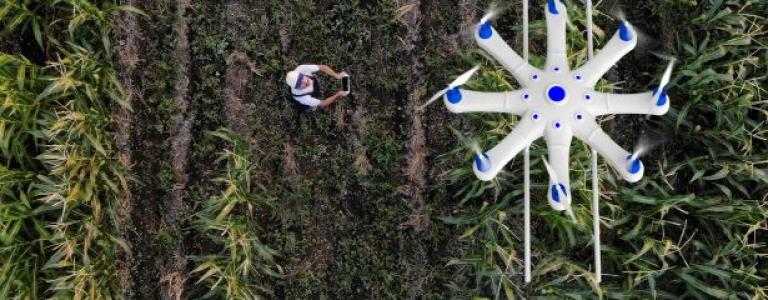Should We Have Impact Assessments for Disruptive Technologies?
If we don’t create basic assessment systems to make sure we’re using new technologies to advance carbon-neutrality and sustainability, we put our future at risk.
Imagine that you live in a neighbourhood with a public park at its centre. Your community has always used it as an informal gathering space—it’s free, it's always open and everyone is welcome. As an added bonus, the trees and other vegetation provide places for wildlife to live and help remove carbon dioxide from the atmosphere.
One day, construction starts in the park, but site workers can’t disclose any details about it. Eventually, when the hoarding surrounding the area is removed, a new waste incinerator is revealed. At the grand opening, the project’s leaders cite multiple benefits for sustainable development. Soon after, trucks start arriving at your doorstep, collecting waste and transporting it to the new facility.
A few neighbours are pleased that this private initiative will lower waste management fees. Some welcome the fact that local roads will be upgraded as a side-benefit of the project. Some speculate that it may eventually create more jobs. Others, however, express concern about the incinerator’s potential emissions, impacts on public health, the value of their properties, and risks of malfunctions and accidents. When you ask a local authority, it becomes clear that the project developer was not required to consider or disclose any potential adverse impacts and risks. This entire initiative is protected by commercial confidentiality.
Does this scenario sound absurd to you? It might. Most of us live in societies that require the developers to first carry out environmental impact assessments (EIAs) and formally consult the potentially affected or concerned public and relevant authorities before going ahead with a project. These processes are in place in all countries globally and support decision-making on proposed actions that may affect the environment, economy or society (see Box 1, below).
Now, what if we swap the waste incinerator in the example above with a new technology project? And what if, instead of being hypothetical, it’s actually happening now, in real life?

Disruptive innovation (think ride-sharing apps) and exponential technologies (such as artificial intelligence) are already affecting people in discrete, yet potentially significant ways. There are increasing concerns about data collection, surveillance, behaviour management and the shake-up of local economies as automation takes over. And yet, no comparable impact assessment obligations apply to these types of business initiatives.
Take, for example, ongoing concerns around a proposal in Toronto, Canada, that would see Google's Sidewalk Labs develop a large swath of the city’s waterfront and collect unspecified data on the movements and habits of people inhabiting this space. The persistent media coverage of the project is symptomatic of a broader concern among the general public regarding the impact of the Internet of Things and artificial intelligence on our communities.
Municipalities are starting to be more systematic about asking the right questions before giving the green light on new tech projects: verifying who owns, protects and uses collected data; determining long-term technological lock-ins and dependencies on external service suppliers; and analyzing the life-cycle costs of cyber-physical systems, along with their maintenance needs and vulnerabilities.
But from an environmental and climate change angle, we must also start to inquire more about the electricity demands of technology that is based on machine-driven interactions and transactions that come with significant power demands. We should also be looking at the electronic waste associated with a high proliferation of plug-in appliances and equipment. And we may wish to learn how discrete algorithms and hidden commercial interests built into various digital platforms change our consumption patterns and their sustainability (or lack thereof).
Inevitably, we will find complicated pros and cons with plenty of double-edged swords. For instance, autonomous transport systems—such as self-driven cars—provide on-demand mobility, facilitate vehicle sharing (which reduces the number of cars on the road), and increase energy efficiency per journey through route optimization and improved driving behaviour. On the flip side, they will likely lead to greater demand for road-based transportation, worsen urban sprawl, and require ongoing upgrades in energy supply and infrastructure.
Similarly, additive manufacturing (e.g., 3D printing) may, on the one hand, provide custom-made and highly functional products, reduce the material intensity and weight of traditionally made products, and simplify logistical requirements through decentralized manufacturing, which takes place closer to customers. Yet this type of production may require more energy than conventional manufacturing; it may also potentially ramp-up resource consumption by providing affordable objects that are difficult to fix or even dismantle for waste-recovery purposes.

Simply put, nearly all next-generation technologies come with benefits and side effects. As Melvin Kranzberg famously stated, “technology is neither good nor bad, nor is it neutral.” Indeed, “technology is a very human activity,” and, as such, its effects depend on the intentions and skills of its users, as well as on the context of its application. Since these impacts may be diverse, the ultimate question is: Who should be responsible for determining and evaluating the inconvenient side-effects of new tech? Should this be the task of society, governments, academia or the business sector?
Right now, concerns about the potential adverse impacts of disruptive technologies seem to be left to the most vocal critics. Developers are not required to properly anticipate their potential risks and side-effects or engage the potentially affected societies in discussions about the economic, social or environmental impacts of their creations.
To use the terminology of environmental regulation, we are currently in a technological “pre-NEPA” phase. We don’t have processes for well-organized public debates about the potentially significant impacts of disruptive technology projects before their deployment. Yet, books like The Second Machine Age, Homo Deus or Life 3.0 are giving us clear warning signals about the potential side-effects of our growing technological capacities, serving as modern-day parallels to the environmental alarm bells sounded by Rachel Carson in Silent Spring in the 1960s.
We were smart enough 50 years ago to invent the first EIA system. So, considering the forthcoming Fourth Industrial Revolution, do we need IAs for disruptive digital technologies? If not, what would be the alternative? If we don’t create at least basic assessment systems to ensure we’re using next-generation technologies for our benefit and to advance social cohesion, carbon-neutrality and sustainability, we put our future at risk.
Box 1: Impact Assessments (IA) Formal EIAs for federal actions (at the project and strategic decision-making levels) were first constituted in 1969 through the United States National Environmental Policy Act (NEPA) following a decade of growing environmental awareness and a series of disasters such as the Cuyahoga River Fire, which acted as the final wake-up call. Following the passage of NEPA, EIA (focused at the project level) and Strategic Environmental Assessment (focused at the policy-, plan- and program-levels) have become globally widespread and have also inspired other IAs that focus on social repercussions, health effects, biodiversity and other factors. The International Association for Impact Assessment (IAIA) describes these tools as processes for identifying the future consequences of a current or proposed action. At their core, IAs ensure that proponents of new initiatives with potentially significant societal impacts identify and assess such impacts and risks, consider alternatives and mitigation measures, and make these findings available to relevant authorities and the public for consideration. The main features of EIA processes are summarized in IISD’s EIA: Essentials. Information on other IA tools can be found in IAIA’s Resources. |
Those interested in exploring this issue further are welcome to reach out to the IAIA's emerging technologies team here.
Jiří Dusík is co-chair, IAIA Section on Emerging Technologies, Integra Consulting, Ltd.
Alan Bond is co-chair, IAIA Section on Emerging Technologies, University of East Anglia (UK) and North West University (South Africa)
Barry Sadler is former Chief Executive of IEMA and EIA Adviser to the United Nations Environment Program
You might also be interested in
Financial Benefit-Sharing Issues for Critical Minerals: Challenges and opportunities for producing countries
Exploring nuances in the key features of critical minerals and the new challenges and opportunities they present to fiscal regulation.
National State of the Environment Report: Uzbekistan
The National State of the Environment Report (NSoER) is a comprehensive document that provides a snapshot of current environmental trends in Uzbekistan's socio-economic development for citizens, experts, and policy-makers in the country of Uzbekistan.
IGF Case Study: Leveraging Technologies for Gender Equality in Mining Communities
How can sharing technological infrastructure support gender equality and serve the broad betterment of mining communities?
Carbon capture tax credit could cost taxpayers $1B more than expected, PBO warns
A controversial tax credit meant to help jump-start carbon capture projects could cost $1 billion more than the federal government estimated, says the independent parliamentary budget watchdog. In several federal budgets, Finance Canada forecast that the carbon capture, utilization and storage (CCUS) investment tax credit would cost $4.6 billion between 2022-28. The Parliamentary Budget Officer now estimates the CCUS investment tax credit will cost $5.7 billion.
